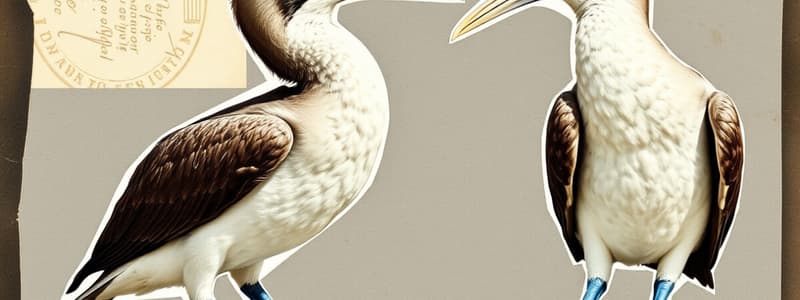Podcast
Questions and Answers
What is the primary purpose of the male Blue-footed Booby's dance during courtship?
What is the primary purpose of the male Blue-footed Booby's dance during courtship?
- To establish territory
- To showcase his intelligence
- To assert dominance over other males
- To impress the female (correct)
What are innate behaviors primarily described as?
What are innate behaviors primarily described as?
- Behaviors learned through social interaction
- Genetically controlled behaviors with little environmental influence (correct)
- Behaviors influenced by environmental factors
- Species-specific behaviors requiring practice
Which of the following best describes an instinct?
Which of the following best describes an instinct?
- A learned response to environmental changes
- A complex behavior requiring intelligence to execute
- A behavior that must be practiced to improve
- An automatic response to a specific stimulus (correct)
What distinguishes innate behaviors from other behaviors in animals with higher intelligence?
What distinguishes innate behaviors from other behaviors in animals with higher intelligence?
Which of the following is listed as an example of an innate behavior in humans?
Which of the following is listed as an example of an innate behavior in humans?
Which of the following is an example of an innate behavior in humans?
Which of the following is an example of an innate behavior in humans?
What distinguishes learned behaviors from innate behaviors?
What distinguishes learned behaviors from innate behaviors?
Which type of learning involves sudden insights or flashes of understanding?
Which type of learning involves sudden insights or flashes of understanding?
Which example illustrates the concept of insight learning in animals?
Which example illustrates the concept of insight learning in animals?
What role does playing serve in the development of behavior among young animals?
What role does playing serve in the development of behavior among young animals?
Reflex behaviors in human babies are considered innate behaviors.
Reflex behaviors in human babies are considered innate behaviors.
Insight learning primarily involves trial and error to solve problems.
Insight learning primarily involves trial and error to solve problems.
Humans are the only species known to create tools through insight learning.
Humans are the only species known to create tools through insight learning.
Learning behaviors are generally more flexible than innate behaviors.
Learning behaviors are generally more flexible than innate behaviors.
The grasp reflex occurs in adult humans as a learned behavior.
The grasp reflex occurs in adult humans as a learned behavior.
The courtship display of the Blue-footed Booby is an example of an innate behavior.
The courtship display of the Blue-footed Booby is an example of an innate behavior.
Humans display a variety of innate behaviors that include complex problem-solving and strategic thinking.
Humans display a variety of innate behaviors that include complex problem-solving and strategic thinking.
Innate behaviors are influenced heavily by environmental factors and need to be learned through practice.
Innate behaviors are influenced heavily by environmental factors and need to be learned through practice.
All innate behaviors are essential for an animal's survival or reproduction.
All innate behaviors are essential for an animal's survival or reproduction.
A human infant's grasping reflex is an example of a learned behavior.
A human infant's grasping reflex is an example of a learned behavior.
Flashcards are hidden until you start studying
Study Notes
Blue-footed Booby Courtship
- Male Blue-footed Boobies attract females by flaunting their blue feet and performing a dance, which includes spreading wings and stamping feet.
- Courtship behavior is an example of innate behavior motivated by genetic factors.
Innate Behavior
- Instinctive behaviors are largely controlled by genetics, requiring no learning or practice.
- Occurs naturally across species in reaction to specific stimuli, ensuring survival and reproductive success.
- Examples include a dog's drooling upon seeing food and the grasp reflex in human infants.
Significance and Characteristics
- Innate behaviors are predictable and performed uniformly by all members of a species.
- Critical for basic life functions such as foraging for food and nurturing offspring, as incorrect execution can jeopardize survival.
Intelligence and Innate Behavior
- While all animals exhibit innate behaviors, these are less common in more intelligent species.
- Humans primarily demonstrate reflexes as their sole innate behaviors due to high levels of learning and adaptability.
Reflex Behaviors in Humans
- Reflex behaviors, particularly in infants, aid survival; examples include the sucking and grasp reflexes.
- Human behaviors are largely influenced by experience and learning, contrasting sharply with innate actions.
Learning and Its Importance
- Learning represents a behavioral change due to experience, offering flexibility and adaptability to animals compared to instinctive responses.
- Essential for acquiring skills such as driving, where conditions necessitate adjustment of learned behaviors.
Types of Learning
- Various types of learning include habituation, insight learning, conditioning, playing, and observation.
- Each type reflects different ways animals adapt and modify behavior in response to their environment.
Insight Learning
- Characterized by problem-solving based on past experiences and reasoning; a sign of advanced intelligence.
- Humans excel in insight learning, enabling innovative solutions for complex challenges (e.g., scientific advancements).
Tool-Making and Learning
- Initially believed to be unique to humans, tool-making has been observed in chimpanzees and other animal species, showcasing their capacity for insight learning.
- Notable examples include chimpanzees using sticks to fish termites and crows crafting hooks for retrieving food.
Blue-footed Booby Courtship
- Male Blue-footed Boobies attract females by flaunting their blue feet and performing a dance, which includes spreading wings and stamping feet.
- Courtship behavior is an example of innate behavior motivated by genetic factors.
Innate Behavior
- Instinctive behaviors are largely controlled by genetics, requiring no learning or practice.
- Occurs naturally across species in reaction to specific stimuli, ensuring survival and reproductive success.
- Examples include a dog's drooling upon seeing food and the grasp reflex in human infants.
Significance and Characteristics
- Innate behaviors are predictable and performed uniformly by all members of a species.
- Critical for basic life functions such as foraging for food and nurturing offspring, as incorrect execution can jeopardize survival.
Intelligence and Innate Behavior
- While all animals exhibit innate behaviors, these are less common in more intelligent species.
- Humans primarily demonstrate reflexes as their sole innate behaviors due to high levels of learning and adaptability.
Reflex Behaviors in Humans
- Reflex behaviors, particularly in infants, aid survival; examples include the sucking and grasp reflexes.
- Human behaviors are largely influenced by experience and learning, contrasting sharply with innate actions.
Learning and Its Importance
- Learning represents a behavioral change due to experience, offering flexibility and adaptability to animals compared to instinctive responses.
- Essential for acquiring skills such as driving, where conditions necessitate adjustment of learned behaviors.
Types of Learning
- Various types of learning include habituation, insight learning, conditioning, playing, and observation.
- Each type reflects different ways animals adapt and modify behavior in response to their environment.
Insight Learning
- Characterized by problem-solving based on past experiences and reasoning; a sign of advanced intelligence.
- Humans excel in insight learning, enabling innovative solutions for complex challenges (e.g., scientific advancements).
Tool-Making and Learning
- Initially believed to be unique to humans, tool-making has been observed in chimpanzees and other animal species, showcasing their capacity for insight learning.
- Notable examples include chimpanzees using sticks to fish termites and crows crafting hooks for retrieving food.
Studying That Suits You
Use AI to generate personalized quizzes and flashcards to suit your learning preferences.




